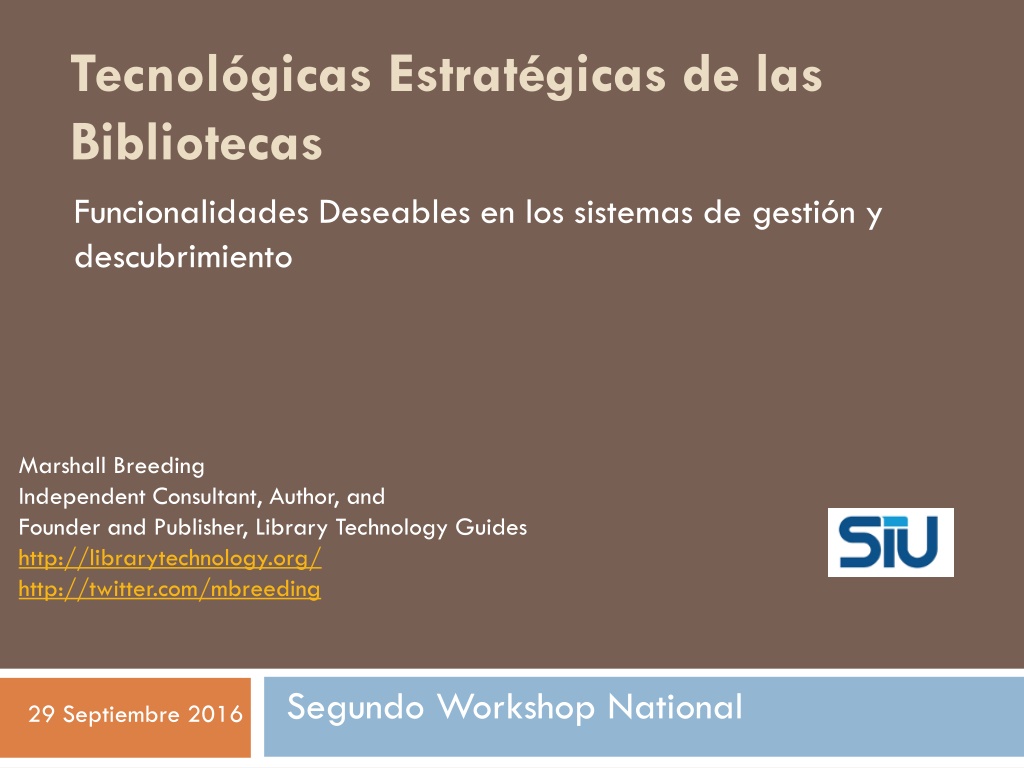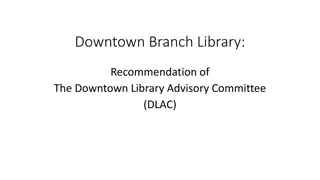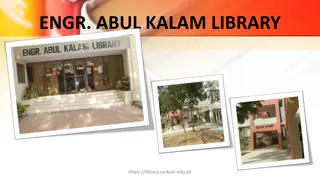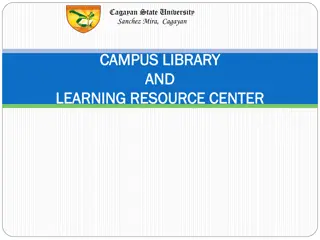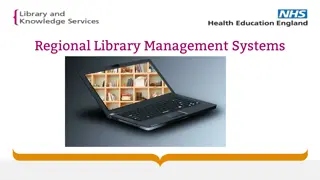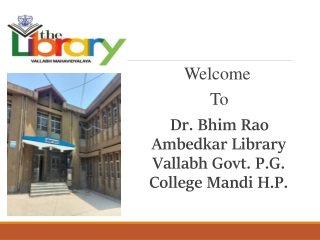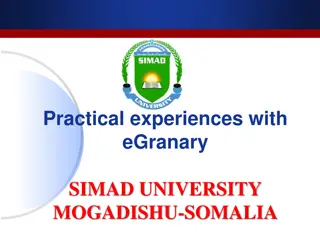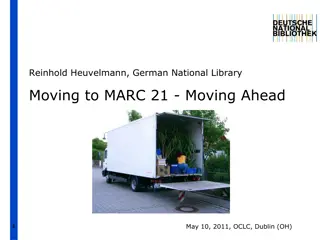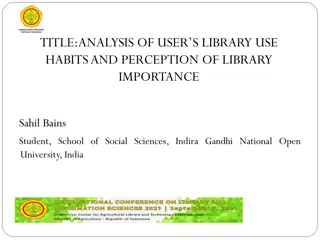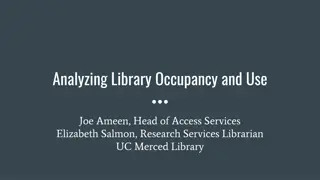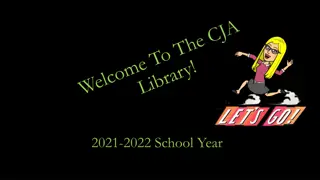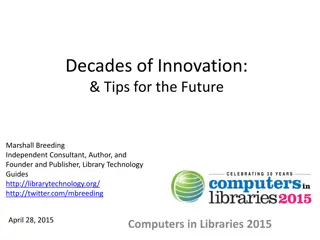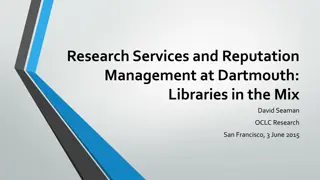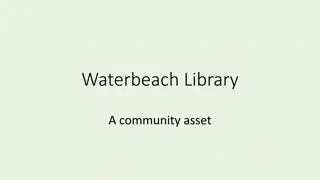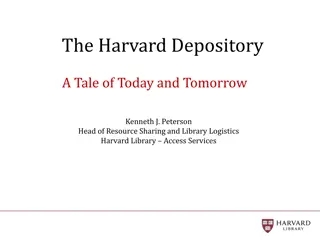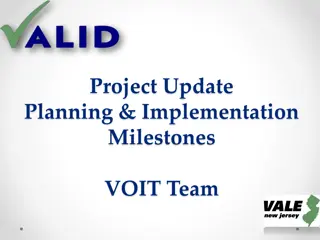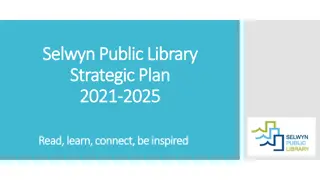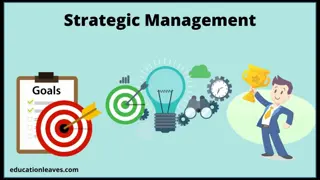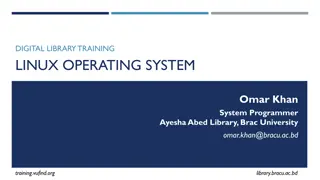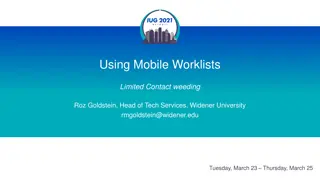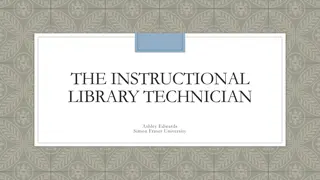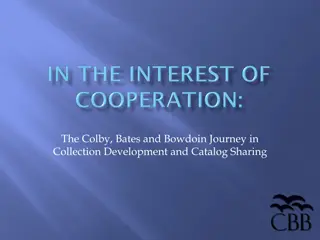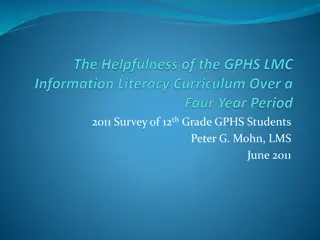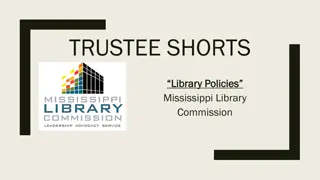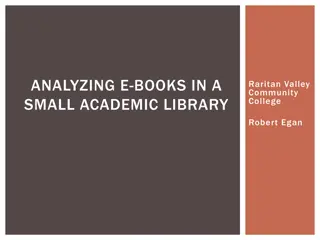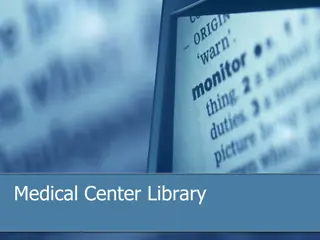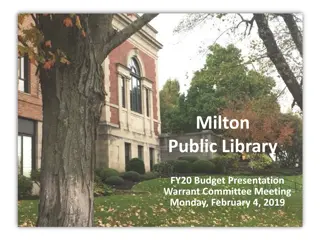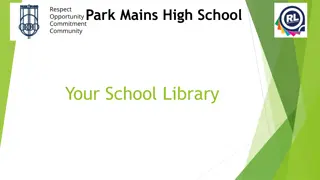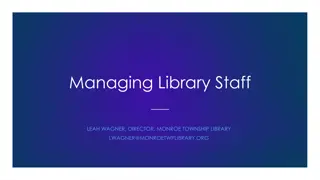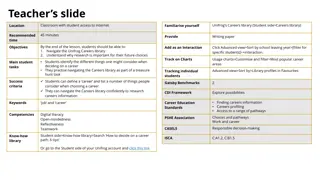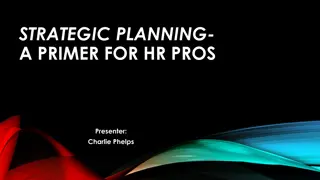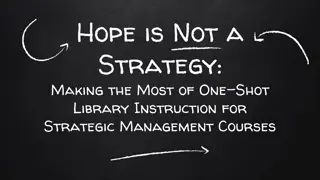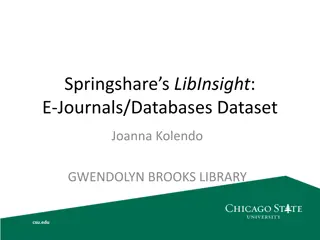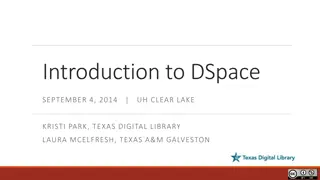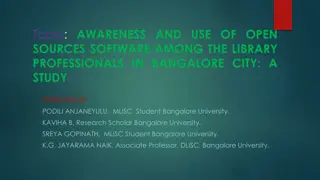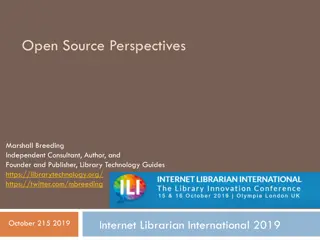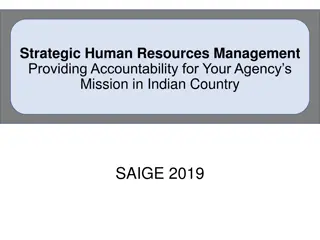Strategic Features for Future Library Management Systems
This content discusses the desirable functionalities in library management systems, including challenges in handling non-traditional items like laptops and ebooks. It explores the relationship with BIBFRAME, the semantic web, and institutional repositories, highlighting the need for technology products to support libraries effectively amidst industry changes.
Download Presentation

Please find below an Image/Link to download the presentation.
The content on the website is provided AS IS for your information and personal use only. It may not be sold, licensed, or shared on other websites without obtaining consent from the author. Download presentation by click this link. If you encounter any issues during the download, it is possible that the publisher has removed the file from their server.
E N D
Presentation Transcript
Tecnolgicas Estratgicas de las Bibliotecas Funcionalidades Deseables en los sistemas de gesti n y descubrimiento Marshall Breeding Independent Consultant, Author, and Founder and Publisher, Library Technology Guides http://librarytechnology.org/ http://twitter.com/mbreeding Segundo Workshop National 29 Septiembre 2016
Abstract Topics covered will include we are very interested in your perceptions about the features that are needed today and that will be in the future for a library management environment. What is the relation of these products to BIBFRAME, the semantic web, the interaction with institutional repositories, challenges in loan of non-traditional items as laptops, ebooks, etc.
Thanks To OCLC for funding my travel to the workshop
Library Technology Industry Reports American Libraries Library Journal 2013: Rush to Innovate 2014: Strategic Competition and Cooperation 2015: Operationalizing Innovation 2016: Power Plays 2012: Agents of Change 2011: New Frontier 2010: New Models, Core Systems 2009: Investing in the Future 2008: Opportunity out of turmoil 2007: An industry redefined 2006: Reshuffling the deck 2005: Gradual evolution 2004: Migration down, innovation up 2003: The competition heats up 2002: Capturing the migrating customer
Library Systems Report 2016 Power Plays https://americanlibrariesmagazine.org/2016/05/02/library-systems-report-2016/
Power Plays The transitions seen in 2015 were not lateral changes of ownership among investors but strategic acquisitions that concentrated power among a smaller number of much larger companies and reassembled product portfolios. Libraries may resist consolidation, but this could enable the development of technology products and services that are less fragmented and better able to support libraries as they provide access to increasingly complex collections.
International Perceptions Report http://librarytechnology.org/perceptions/2015/ Based on a series of annual surveys addressed to libraries Probes levels of satisfaction with their automation systems 3,453 responses to 2015 survey 1,050 narrative comments Conducted since 2007: view trends over time Data collected Nov-Dec, published early the following year Linked to entries in libraries.org
Perspective Increasing divergence among library types regarding requirements for supporting technical infrastructure: Academic, Public, National, School, Special Approaches to library service vary according to international region Broad range of economic capacity or support across countries and regions and even within some countries. (especially United States)
Broad Industry Trends Continued Consolidation International companies increasingly dominate in a growing set of international regions Discovery services now routine infrastructure in academic libraries New Generation systems becoming better established New and existing systems shifting to hosted or SaaS deployment Subscription-based technology infrastructure or cloud- housed systems rather than local hardware
Transformation in Bibliographic Management Traditional bibliographic conventions undergoing transformation RDA: new set of cataloging rules Linked Data: increased interest in applying to library collections BIBFRAME: mapping of MARC21 to Linked Data Library involvement with institutional research data Support of Digital Humanities: Text-encoding Initiative and other analytical tools
RDA Resource Description and Access http://www.loc.gov/aba/rda/ Major change relative to resources devoted to transition Minor impact relative to operational and strategic use of metadata
BIBFRAME Emerged from the Initiative for Bibliographic Transformation of the Library of Congress http://www.loc.gov/bibframe/ bibframe.org Replacement for MARC (Machine Readable Cataloging), but broader in scope Encoded using RDF (Resource Description Framework) Major departure from MARC Today more conceptual than operational
Transformacin de las tecnologas Arquitectura orientada a servicios nfasis en las Interfaces de programaci n de aplicaciones Integraci n de las aplicaciones sociales en infraestructura b sica Computaci n local a cambio de plataformas en la nube Nuevas expectativas para m ltiples usuarios de software-as-a-service Soporte para todos los tipos de dispositivos de tama o completo computadoras / tablet / m vil
Tecnologas de la Computacin en Nube (Cloud Computing) Las principales tendencias en Tecnolog a de la Informaci n Esencialmente la externalizaci n del alojamiento y gesti n del servidor Productos de automatizaci n de la mayor a de las nuevas versiones con un cierto sabor de computaci n en la nube Depende del ancho de banda de Internet, que sea r pida y fiable (fast and reliable)
Biblioteca de automatizacin en la nube Casi todos los proveedores de automatizaci n de bibliotecas ofrecen alg n tipo de servicios basados en la nube La responsabilidad de la administraci n de servidores se mueve de la biblioteca a los Proveedores Basado en suscripci n el nuevo modelo de negocio: El pago integral de suscripci n anual Reduce la necesidad de apoyar la tecnolog a local
Cambios en el escenario de automatizaci n de bibliotecas SIGB (Sistema Integrado de Gesti n de Biblioteca) sigue siendo el coraz n de la infraestructura Inter s estrat gico en tecnolog as de descubrimiento fuerte necesidad de herramientas para gestionar los recursos electr nicos Tendencia hacia la gesti n de recursos unificado
Las tendencias en modelos de implementaci n de automatizaci n Mayor inter s en proyectos de cooperaci n para reducir los costos de automatizaci n y para aumentar el impacto de las colecciones Iniciativas regionales, estatales, nacionales y de infraestructura de automatizaci n Ejemplos reciente incluyen Dinamarca, Irlanda, Orbis-Cascade Alliance Los SIGB independientes siguen donde la cooperaci n a gran escala no es posible
SIGB de cdigo abierto: Escenario Internacional Fuerte inter s en EE.UU., Canad Principalmente a trav s de servicios de soporte comercial pagados Muy poco o ning n inter s en Asia El inter s sigue creciendo lentamente en Europa Cada vez mayor inter s en el software de c digo abierto en Am rica Latina
Library software in Developing Nations Longstanding use of CDS/ISIS based automation tools ABCD released as open source Other CDS/ISIS tools are freeware, but not open source Koha seeing widespread adoption Increasingly dominant for new automation projects Commercial products used mostly by larger well- funded institutions
Differences in Latin American Universities Library systems less likely to be centralized Many separate libraries in Facultades Often have separate library management systems Challenge to provide more systematic resource management and discovery while respecting organizational structure Proportions of print resources generally higher than US universities
Latin American Industry Trends International companies target well-funded libraries As libraries develop, many move to systems from international providers Many operate through regional distributors Local systems and open source dominate smaller and less well funded libraries Cloud technologies often less well suited Bandwidth, annual subscription costs
Operational trends in large Academic Libraries Spending on Electronic Resources dominates budgets Generally flat budgets + 4% annual inflation = budget stress Decreasing spending on print monographs Transition from print to electronic journals complete, shift to e-books underway. Shift physical spaces from collections to user- oriented facilities: computer labs, creative commons, collaborative work areas
Academic library print collections Smaller, but unique collections Many libraries shift print collections to off-site storage Monographs increasingly electronic: E-book collections built via demand driven acquisitions
Resource management technology Integrated Library Systems (mostly oriented to print) Library services platforms Electronic+print+digital
Trends in Resource Sharing Ongoing reliance on traditional ILL Direct consortial borrowing Shared technical infrastructure Multiple independent libraries Collaborative collection development Collective Discovery Expedited request delivery
Shared Technology Infrastructure Increasing interest in shared technology infrastructure among members of library systems and consortia Shift from stand-alone implementations to shared infrastructure Remove obstacles to strategic collaboration Collaborative Collection Development Shared access to collections Re-distribution of technical services Ability to share language experts and subject specialists
Shared infrastructure Projects Orbis Cascade Alliance California State University WHELF (Academic libraries in Wales) University System of Georgia South Australia Complete Florida Plus Program Ireland Public Libraries University of Wisconsin system JULAC (Public Universities in Hong Kong)
Library Services Platforms New genre of resource management Workflows unified across electronic, print, and digital formats Flexible metadata management: MARC, Dublin Core, BIBFRAME, etc Deployed via web-native multi-tenant platform Built-in analytics and decision support Examples: OCLC WorldShare Management Services Ex Libris Alma
Shift from: Integrated library systems More oriented to print resources Server-based technology (hosted or local) Workstation clients for staff functions Traditional organization of functional modules: Cataloging, Acquisitions, Serials management, Circulation.
Adoption trends Still relatively early in transition cycle Association of Research Libraries : 33 out of 120 Academic members have purchased a library services platform Very early adoption stage in developing nations
Interoperability and Extensibility Strong reliance on APIs to dynamically interact with data and functionality of the technology platform Create new services not in the core product Interact with other relevant systems: Student records Financial management systems Suppliers Libraries and other collaborative partners
Express data and functionality externally Learning Management Systems Reading lists External scholarly or professional portals
The Evolution of Library Resource Discovery
Index-based Discovery One tier of a multi-level approach to providing access to collection resources Based on central index populated with article-level metadata and full-text spanning most of the universe of scholarly and professional literature Billions of items indexed Instant relevancy-based search results Interface components with increasing sophistication for exploring library collections
Major Discovery Products ProQuest: Primo + Primo Central; Summon EBSCO Discovery Service WorldCat Discovery Service
Challenge: More integrated approach to information and service delivery Library Web sites offer a menu of unconnected silos: Books: Library OPAC (ILS online catalog module) Search the Web site Articles: Aggregated content products, e-journal collections OpenURL linking services E-journal finding aids (Often managed by link resolver) Subject guides (e.g. Springshare LibGuides) Local digital collections ETDs, photos, rich media collections Metasearch engines Discovery Services often just another choice among many All searched separately
Online Catalog ILS Data Search: Scope of Search Books, Journals, and Media at the Title Level Not in scope: Articles Book Chapters Digital objects Web site content Etc. Search Results
Web-scale Index-based Discovery (2009- present) ILS Data Digital Collections Search: Web Site Content Consolidated Index Institutional Repositories Search Results Aggregated Content packages Profile of Library Subscriptions Open Access E-Journals Usage- generated Data Customer Profile Reference Sources Pre-built harvesting and indexing
Open source in Discovery Flexible and powerful open source interfaces: VuFind (php-based) Blacklight (Ruby on Rails) No open access discovery index Hybrid model: Open source interface + Commercial Index
Bento Box Discovery Model Aggregated Content packages Search: Consolidated Index Open Access VuFind / Blacklight ILS Data E-Journals Search Results Web Site Content Digital Collections Pre-built harvesting and indexing Institutional Repositories
Trends in Open Source Open source now a routine segment of strategic library automation Implementation models: Commercial support Independent with community support Support through governmental organizations Development models Mostly centralized within a commercial community Distributed community
Open source in Latin America Commercial software often not affordable More reliance on Open source software Support by Governmental or Educational organizations Local or regional support communities
ABCD Automatizaci n de Bibliotecas y Centros de Documentaci n CDS/ISIS used extensively in developing nations CDS/ISIS: freeware initially developed by UNESCO Development led by BIRME in Brazil ABCD: New application based on CDS/ISIS tools ABCD developed as an open source integrated library system.
Koha Open source ILS available since 1999 Continuous development Widespread deployment in all regions and library types Small to mid-sized libraries; some large implementations
Koha Originally developed in 1999 for small group of libraries in New Zealand, Horowhenua Library Trust by Katipo Communications, production use by January 2000 Gained widespread use in the United States around 2004-05 and has seen steady growth in use Wide international adoption Used in many thousands of libraries. 2,682 represented in libraries.org, with many large groups not yet registered. Dominant open source SIGB in Latin America
National Projects to deploy Koha Philippines: A systematic effort to install Koha in the public libraries sponsored by the state libraries Turkey: 1,200+ public libraries Spain: Koha-Kobli http://kobli.bage.es/ Argentina. CONABIP (Comisi n Nacional de Bibliotecas Populares) Customized version of Koha: DigiBepe http://www.conabip.gob.ar/faq/digibepe
